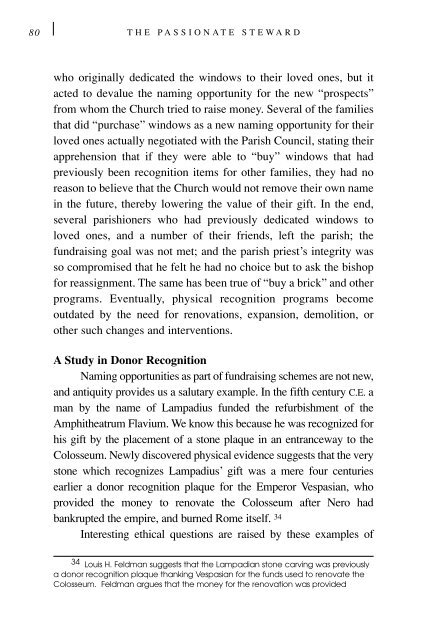Passionate Steward - 10th Anniversary Edition
10th Anniversary Edition of The Passionate Steward - Recovering Christian Stewardship from Secular Fundraising (St. Brigid Press - 2002).
10th Anniversary Edition of The Passionate Steward - Recovering Christian Stewardship from Secular Fundraising (St. Brigid Press - 2002).
You also want an ePaper? Increase the reach of your titles
YUMPU automatically turns print PDFs into web optimized ePapers that Google loves.
80 THE PASSIONATE STEWARD<br />
who originally dedicated the windows to their loved ones, but it<br />
acted to devalue the naming opportunity for the new “prospects”<br />
from whom the Church tried to raise money. Several of the families<br />
that did “purchase” windows as a new naming opportunity for their<br />
loved ones actually negotiated with the Parish Council, stating their<br />
apprehension that if they were able to “buy” windows that had<br />
previously been recognition items for other families, they had no<br />
reason to believe that the Church would not remove their own name<br />
in the future, thereby lowering the value of their gift. In the end,<br />
several parishioners who had previously dedicated windows to<br />
loved ones, and a number of their friends, left the parish; the<br />
fundraising goal was not met; and the parish priest’s integrity was<br />
so compromised that he felt he had no choice but to ask the bishop<br />
for reassignment. The same has been true of “buy a brick” and other<br />
programs. Eventually, physical recognition programs become<br />
outdated by the need for renovations, expansion, demolition, or<br />
other such changes and interventions.<br />
A Study in Donor Recognition<br />
Naming opportunities as part of fundraising schemes are not new,<br />
and antiquity provides us a salutary example. In the fifth century C.E. a<br />
man by the name of Lampadius funded the refurbishment of the<br />
Amphitheatrum Flavium. We know this because he was recognized for<br />
his gift by the placement of a stone plaque in an entranceway to the<br />
Colosseum. Newly discovered physical evidence suggests that the very<br />
stone which recognizes Lampadius’ gift was a mere four centuries<br />
earlier a donor recognition plaque for the Emperor Vespasian, who<br />
provided the money to renovate the Colosseum after Nero had<br />
bankrupted the empire, and burned Rome itself. 34<br />
Interesting ethical questions are raised by these examples of<br />
34 Louis H. Feldman suggests that the Lampadian stone carving was previously<br />
a donor recognition plaque thanking Vespasian for the funds used to renovate the<br />
Colosseum. Feldman argues that the money for the renovation was provided




